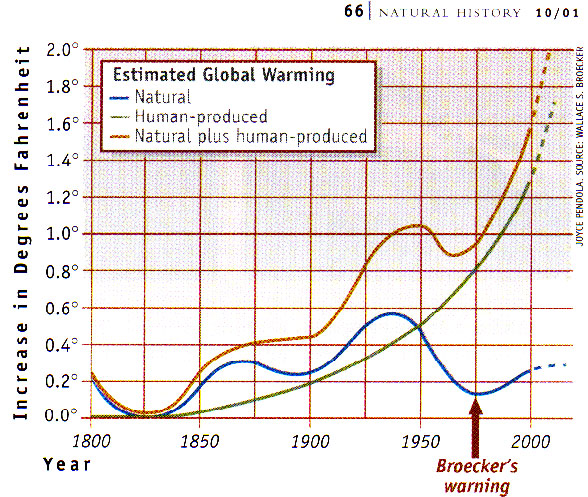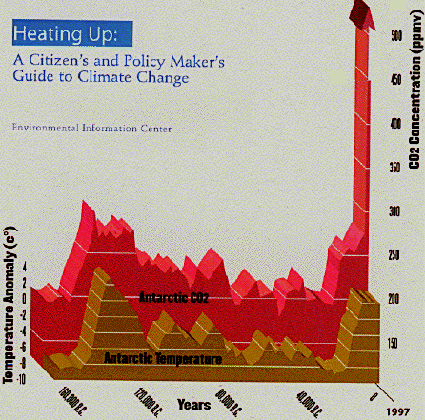"Global transformations
The Changing Atmosphere
232

"Inefficient fossil fuel combustion is not the only source of carbon monoxide."
Civilization and the
Biosphere
The Earth Transformed by Human Action
Global transformations | Climate Change | Life | Crossroads | leading matters
Vaclav Smil, pp 229-262
"The biosphere is a product of constant change. Of course
the rates and impacts of this change vary greatly as periods of surprisingly
conservative evolution are followed by truly revolutionary shifts in the composition
of species or abundance of biomass or as incremental and localized changes
get suddenly swept away by new environments...."
"Above all, the Earth's atmosphere was changed in the intervening time because
of the accumulation of molecular oxygen generated by water-splitting bacterial
and plant photosynthesis. In turn, the oxidizing atmosphere made it possible
to shield the biosphere against UV radiation with stratospheric O3 (ozone)
and to produce such abundant compounds as the metallic oxides and biochemically
important soluble nitrates and sulfates needed for biomass production."
p. 229.
"Life also molded the appearance, structure, and chemistry of the planet's
surfaces and composition of its waters."
"Lovelock went even further, considering the Earth to be a superorganism capable
of homeostasis on a planetary scale maintained by life on the surface."
"the biosphere as an active adaptive control system...."
What does the Gaia principle accomplish?
As a functional concept what does Gaian regulation "accomplish?"-
"He (Lovelock) concluded that this superorganism has the capacity to regulate its temperature and that its health can be measured in the abundance of life."
230
"The biosphere's...immediate future that appears to place our species at perhaps
its most decisive evolutionary junction."
"The diffusion and complexification of human societies have
led to a large array of environmental changes that have transformed this planet
during the last 5000 years and particularly during the past 100 years more rapidly
than any other biogenic process in the planet's history."
".... Both the rate and the depth of the anthropogenic change accelerated with
sedentary agriculture, whose practice often preceded by large-scale deforestation
and maintained by intensifying inputs of nutrients and water."
231
"Global transformations
The Changing Atmosphere
232

"Inefficient fossil fuel combustion is not the only source of carbon monoxide."
233
"Acidifying deposition (wet and dry) arises from atmospheric oxidation of sulphur
and nitrogen oxides.
"The first systematic measurements of background CO2 levels began in 1958 at Mauna Loa and at the South Pole.
Year measured concentration or amount
1958 320 ppm
1999 370 ppm

"This increase of more than 30% in 150 years is of concern because CO2 is a major greenhouse gas whose main absorption band coincides with the earth's peak thermal emission."
"Anthropogenic CO2 has already increased the energy reradiated by the atmosphere by 1.5 watts per meter squared."
"total forcing by other greenhouse gases now roughly equals
that of CO2 ."
234
pH maps of Eastern US 1950s - 1990s
235
"As previously noted, methane levels have roughly doubled during the industrial
era, to about 1.7 ppm by the late 1990s."
"The combined direct and indirect effect of all greenhouse
gases resulted in total anthropogenic forcing of about 2.8 watts per meter squared
by the late 1990s.
236
Ozone depletion by CFCs
atmospheric concentrations have been falling since 1994, " the long atmospheric
lifetime of CFCs means that the stratospheric effect will be felt for decades
to come..."
may return to pre CFC levels by 2050.
237
Land Cover, Soils, and Biodiversity
237
More than ninety definitions for forest have been found in the literature
238
Mathews (1983) put the global area of preagricultural closed forests and woodlands
at 61.5 million square kilometers and estimated that it was reduced to about
52 million square kilometers by the 1980s, a decrease of some 15%.
238-39
"Two conclusions transcend any inevitable differences in such estimates; human
actions have converted a significant share of all natural terrestrial biomes
to other uses, and they have also modified, and often degraded much of the remaining
area of these ecosystems.
239
"Adding up these impacts reveals the total area strongly or partially imprinted
by human activities is about 70 million kilometers square, or no less than 55%
of all non-glacial land.
".. And large areas of grasslands and wetlands continue to
be lost through misuse, conversion to cropland, or aquaculture.
240
"Yet another way to look at the extent of the intensity of the recent transformation
of the biosphere is to estimate the share of GPP (Gross Primary Productivity)
consumed or otherwise processed, managed, or disposed of by human actions."
NPP as much as 40% - 25%
"illustrates the intensity of the biosphere's transformation."
240
"The implications of this impact on biodiversity and on future economic development
are obvious, because even when one starts with the low share, two more consecutive
doublings would do the impossible and appropriate the entire NPP for human use."
241